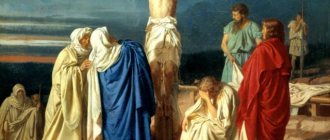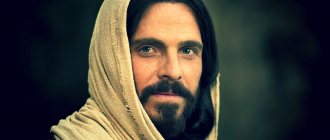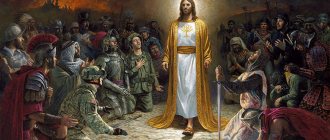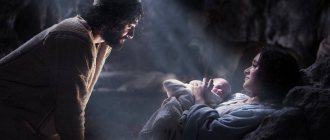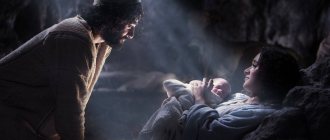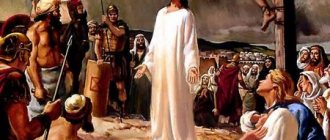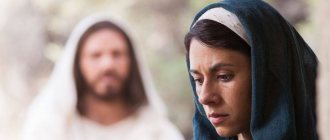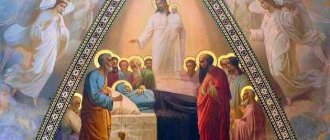Every visible thing in the world is under the command of an angel.
– St. Augustine History of Angels and Demons.
In 2002, the British newspaper The Sunday Telegraph
reported that the Vatican had banned the veneration of those angels that do not appear in the statutory texts of the Bible.
This was an attempt to counter the influence of unnamed age groups who were said to be recruiting new members into the Roman Catholic Church. In the future, prayers were to be directed only to the three archangels Michael, Gabriel and Raphael, who are mentioned in the Bible. According to the apocryphal and banned Book of Enoch,
these were angelic beings responsible for binding the evil fallen angels or observers who violated God's Law.
News reports say that the early Church excluded a book attributed to the Old Testament prophet and patriarch Enoch from the approved version of the Bible because it described these fallen angels and their activities. Who are the watchers or fallen Angels, and why were the early Church and the modern Vatican so concerned about them? Genesis 6:1-4 says, “When men began to multiply on the earth, and daughters were born to them, the sons of God saw the daughters of men that they were just, and they took the wives of all whom they chose.” Traditionally the Ben Eloha
or 'sons of God' numbered several hundred, and they descended to earth on Mount Hermon.
It is noteworthy that this was a sacred place for both the Canaanites and the Jews who invaded their land. In later times, shrines to the gods Baal, Zeus, Helios and Pan and the goddess Astarte were built on its slopes. These Ben Elohim
or 'fallen angels' were also known as the watchers of Gregory and Irene.
In Jewish mythology, Gregory was originally the highest order of angels who lived in the highest heaven with God and resembled humans in appearance. 1
The name 'observer' simply means 'one who watches', 'those who watch', 'those who are awake' or 'those who are awake'.
These names reflect the unique relationship between observers and the human race since ancient times. In the esoteric Luciferian tradition they were a special elite order of angelic beings created by God to be the earthly shepherds of the first primitive people. Their mission was to observe and monitor the emerging human species and report on their progress. However, they were limited by the Divine prime directive not to interfere with human evolution. Unfortunately, they chose to ignore God's command and defy his orders and become teachers of the human race, which has dire consequences for both themselves and humanity. Most of our information about the watchers and their activities comes from the apocryphal book of Enoch
.
In the Orthodox Bible, the prophet Enoch, from Hebrew “hanoch” or mentor, is a mysterious figure. In Genesis 4:16-23 he is described as the son of Cain, “the first murderer,” and the first city built by his father is named after him. Further, in Genesis 5:18-19, and several generations later, Enoch is called the son of Jared, and it is during his lifetime that the watchers either come or incarnate in human bodies. The apocryphal book of Jubilees
is said to have been dictated by an “angel of the Lord” to Moses on Mount Sinai when he also received the Ten Commandments, which states that Enoch was “the first among the people born on the earth [sic] who learn the Scripture, knowledge and wisdom . It says that Enoch wrote down the “signs of the heavens” (the signs of the zodiac) according to their months in the book. This was so that people would know the Seasons in relation to the order of the months and their corresponding stellar and planetary influences. The indication is that Enoch received this information from extraterrestrial angelic sources, i.e. observers, and therefore he was a cultural specimen.
Fallen Angels Teach Humanity
Two hundred “fallen angels” descended from the heavenly kingdom to the top of Mount Hermon, and they were so amazed by the beauty of human women that, using their new material bodies, they had sex with them. This led to Yahweh's even greater wrath and, according to the Bible, the consequence of this mixing between the Fallen and mortals resulted in the creation of half-blooded, half-human offspring (Genesis 6:4). These children were called Nefelim
or
Nephilim
, and they were a giant race that once inhabited the earth.
The fallen angels trained their wives and children in a variety of technological skills, magical knowledge, and occult wisdom. This suggests that psychic abilities and magical powers were originally an ancient inheritance from the angelic realm given to early humans. In the Luciferian tradition, this is known in spiritual and metaphorical terms as “witch blood,” “Elf blood,” or “fae blood,” which is possessed by witches and wizards. The Book of Enoch
states that the leader of the fallen angels was called Azazel, and he is often identified with Lucifer (Lightbringer) or Lumiel ('light of God').
He taught men to forge swords and make shields and badges (body armor). Azazel also taught them metallurgy and how to mine and use various metals from the earth. He taught women the art of making bracelets, jewelry, rings and necklaces from precious metals and stones. He also showed them how to “decorate their eyelids” with a stake and use cosmetic tricks to attract and seduce the opposite sex. From this practice, Enoch says that much “godlessness” came, and men and women who committed fornication were led astray and became corrupt. This was the basis for the early Church condemning fallen angels for teaching women to make necklaces from pieces of gold and bracelets for their hands. St. Paul said that women should cover their heads in the synagogue (Corinthians: 11:5-6). This was because fallen angels were supposed to be attracted to human women with long flowing hair. The custom of women covering their hair in churches is still found in Roman Catholicism as well as in Islamic practices. The fallen angel Shemyaza, another form of Azazel, told Enoch that he taught the people the use of root cuttings and the magical art of enchantment; the fallen angel Armaros taught the resolution (expulsion) of spells; Baraqijal taught astrology; Kokabiel, knowledge of constellations (astronomy); Chazaqiel, knowledge of clouds and sky (ENT weather and divination); Shamsiel, solar sun signs (solar signs); Sariel - the course of the Moon (lunar cycles used in gardening and agriculture and esoteric lunar secrets); Penemuel taught people the art of writing and reading; Kashdehan taught diagnosis and healing of diseases and the science of medicine. From these descriptions of the educational abilities of the observers, it is clear that they were the cultural models and carriers of civilization of the early human race. It is therefore strange that in Orthodox Judeo-Christian religious texts they are distorted as evil corrupters of humanity. Some ideas about the original exalted status and real nature of the “sons of God” and “angels of the Lord” can be found in the ancient records of angelic traditions. For example, Kokabiel is described as “the great angelic prince who rules the stars.” 2
In the Sibylline Oracles, Araqiel is one of the fallen angels who accompany the souls of the dead to judgment in the underworld.
Shamsiel, perhaps originally the Babylonian sun god, was called the “prince of Paradise” because he was one of the guardian angels who watched over the gates to Eden. In this role, he took Moses to see the heavenly garden, and he also observed the treasures of King David and his son Solomon the Wise. This reference may be to spiritual treasures rather than physical gold and jewelry. In the Jewish Zohar
he is named the chief adjutant of the mighty Archangel Uriel and carried him into battle.
Sariel was an angel associated with the fertility of the earth and the spring equinox (Northern Hemisphere) in March. It ruled the martial zodiac sign Aries the Ram and was called upon to protect against the malefic power of the evil eye.
Azazel-Lucifer-Lumille
Azazel, the leader of the Watchers, as mentioned earlier, was identified with Lucifer or Lumiel. The Qur'an states that Lucifer-Lumil (Iblis) rebelled against Allah because he was commanded to bow down and worship the clay born of the “man of the earth” Adam and abandonment. He was forced to fight in heaven with Archangel Mikael or Michael and his army of the Lord. As a result, Lumil and his rebellious angels were expelled from heaven and fell to Earth. Here Lumil became the “Lord of the World,” and in Christian mythology he was falsely identified with the theologian Satan. However, esoterically in the Luciferian tradition, Lumil or Lumius is not an evil satanic figure luring humanity into temptation and acts of evil, as the Church presents him. He is “an angel of God [who] rebelled against the static, established cosmic order and set in motion the forces of change and development...” 3
It is possible that Lumil appeared in Canaan as Shahar, the God of the morning star (Venus).
He had a twin named Shalem, who was also symbolized by the Planet Venus, but as the evening star. These divine bright and dark twins represented the light of the sun emerging from the darkness of the night at dawn and descending into it at dusk. They were the children of the goddess Asherah, and there is archaeological evidence from the Middle East that the Jews adopted her worship when they settled in Canaan and practiced it along with reverence for the tribal storm of the God Yahweh. There are several references in the Old Testament to the continued worship of Asherah as the “queen of heaven” by supposedly monotheistic Jews. This took place in sanctuaries in sacred groves on the hills, where they made offerings of cakes and incense to the goddess. In Canaanite mythology, Shahar, as the Lord of the morning star, was cast out of heaven for challenging the high God El in the form of lightning. In this form, he impregnated mother earth with his Divine phallic power. Azazel is presented as a metalsmith and a sorcerer or Magician. He has also been compared to the biblical first blacksmith Tubal-Cain, a descendant of the half-human, half-angelic “first murderer” Cain. Azazel's real name has been variously translated as “God of Victory,” “Power of God,” “Strong God,” and even “Goat God.” In the apocryphal Apocalypse of Abraham
he is called “ruler of the Gentiles,” suggesting that he was originally a pagan God.
He was also identified with the serpent in the Eden myth that seduced the first woman and “mother of all living things,” Eve. In a Persian text known as the Urm Al-Khibab
or
Primordial Book
, dating from the 8th century AD, the angel Azazil or Azazel is said to have refused to recognize Adam's superiority over the angels.
As a result, Allah banished him and his rebel angels from the heavenly kingdom to live on Earth. More generally, in Islamic lore, Azazel or Azrael is the angel of death, and he acts as a guide for the souls of the dead. Leviticus 16:8-10 and the Dead Sea Scrolls record a curious Jewish ritual in which Azazel is named as the “scapegoat” who takes upon himself the common sins of Israel. It says that the high priest Aaron took two goats from the herd and cast lots (a practice of divination) to choose which one would be the scapegoat and sacrificed as a “sin offering.” The Scrolls say that the high priest confessed all the “admixtures of the children of Israel” over the head of the Azazel goat. With this ritual and symbolic act, he transferred all his guilt and sins to the unfortunate animal so that they could be absolved. The goat was then either driven into the desert to die or thrown onto a rock to be broken into pieces on the rocks below. This ancient and archetypal concept of a scapegoat being sacrificed for the sins of the human race and left in the wilderness is a powerful and powerful motif that appears several times in biblical myths. This can be seen in the story of Cain, who becomes an exiled wanderer on Earth after being marked by God and banished “east of Eden” after killing his brother Abel. In one Jewish legend, the wise King Solomon, a powerful magician who could summon and control demons, fell from grace because he “wandered after strange gods.” He was forced by God to leave Jerusalem and wander the desert disguised as a beggar. Also after their exodus from slavery in Egypt, Moses and the Israelites were forced to spend forty years wandering in the wilderness before they were allowed to enter the promised land (Canaan). In ancient Egyptian mythology, the Dark God is represented as a divine outcast living in the desert, and after she abandoned Adam, his first wife Lilith or Lily fled into the desert from human habitation. In the New Testament, Jesus wandered in the desert for forty days and nights. He was not accepted as a teacher in his city of Nazareth and was rejected by his people as the promised Messiah. When Jesus was crucified, he symbolically took on the role of the sacrificial scapegoat who dies to cleanse the sins of the human race. It is possible that the story of the rites of the goat-God Azazel could be the autumnal equinox or harvest rite of Syrian, Hittite or Canaanite origin, adopted by the Jews. Initially, the goat would have been chosen through a divination ritual and then offered to the desert god or demon, who would have been appeased by the shedding of blood. Ultimately, the sacrifice was made to Yahweh as a petition to forgive the sins of his followers. Azazel was popularly considered to be the retinue of a hairy goat of demons known as YV'irim
who, like the observers, lusted after human women.
It cannot be a complete coincidence that the Church imagined the Devil or Satan as a hairy, semi-human male goat with a massive erect phallus who had sexual intercourse with his female worshipers on the Sabbath of Witches. Shemyaza is considered by some modern Luciferians to be either an emissary of Lumil or one of his avatars (an incarnate divine being in human form). He not only fell in love with human women, but also with the Babylonian deity Ishtar, the goddess of love and war. She promised to have sex with him if he would reveal to her the secret name of God in return. When Shemyaza told her, Ishtar used this forbidden knowledge to ascend to the stars, and she reigned over the constellation of the Pleiades or the seven sisters. While the other observers were captured by the archangels and punished by God, Shemyaza voluntarily repented of his error and sentenced himself to hang himself in the constellation of the hunter Orion, with whom he is sometimes identified in the Luciferian tradition. In the Gabalist tradition, Naamah, the sister of the first biblical Smith, Tubal-Cain, seduced Azazel and was related to Ishtar. Four
Orthodox teaching about angels
We know from the words of Christ Himself that at the moment of death the soul is met by Angels: The beggar died and was carried by the Angels to Abraham’s bosom
(
OK. XVI, 22
).
Also from the Gospel we know in what form the Angels appear: The Angel of the Lord... his appearance was like lightning, and his clothes were white as snow
(
Matthew XXVIII, 2-3
);
a young man dressed in white clothes
(
Mark XVI, 5
);
two men in shining clothes
(
Luke XXIV, 4
);
two Angels in white
(
John XX, 12
).
Throughout Christian history, the apparitions of Angels
have always had the appearance of BRILLIANT YOUTHS DRESSED IN WHITE.
The iconographic tradition of the appearance of Angels has always been consistent with this for centuries: only such shining youths were depicted (often with two wings, which, of course, are symbolic and are usually not visible during the appearance of Angels).
Council in 787 decreed that Angels should always be depicted in only one form, as men. Western cupids of the Renaissance and subsequent periods are inspired by paganism and have nothing in common with real Angels.
Canonical image of angels
And in fact, the modern Roman Catholic (and Protestant) West has moved far away from the teachings of Holy Scripture and early Christian tradition, not only in the artistic depiction of Angels, but also in the very doctrine of spiritual beings. Understanding this error is essential for us if we want to truly understand the true Christian teaching about the posthumous fate of the soul.
One of the great fathers of the recent past, Bishop Ignatius Brianchaninov
(+ 1867), saw this error and devoted an entire volume of collected works to identifying it and presenting the true Orthodox teaching on this issue (vol. 3. Tuzov Publishing House, St. Petersburg, 1886).
Criticizing the views of the exemplary Roman Catholic theological work of the 19th century ( Abbé Bergier's
Theological
Dictionary
),
Bishop Ignatius
devotes a significant part of the volume (pp. 185-302) to the struggle with modern thought, based on the philosophy
of Descartes
(17th century), that everything is outside the kingdom of matter simply belongs to the kingdom of pure spirit.
Such a thought, in essence, places the infinite God
on the level of various finite spirits (Angels, demons, souls of the dead). This idea has become especially widespread in our time (although those who adhere to it do not see all its consequences), and largely explains the misconceptions of the modern world regarding “spiritual” things: great interest is shown in everything that is outside the material world, and at the same time often little distinction is made between the Divine, the angelic, the demonic, and simply the results of unusual human capabilities or imagination.
Abbe Bergier
taught that Angels, demons and souls of the dead are purely spiritual beings;
therefore, they are not subject to the laws of time and space. We can talk about their form or movement only metaphorically, and “ they have the need to put on a subtle body when God allows them to act on bodies
” (
Bishop Ignatius
. Vol. 3, pp. 193-195).
Even an otherwise knowledgeable twentieth-century Roman Catholic work on modern spiritualism repeats this teaching, stating, for example, that Angels and demons “ can borrow the required material (to become visible to humans) from lower nature, whether animate or inanimate.”
"
Spiritualists and occultists themselves picked up these ideas of modern philosophy. One such apologist for supernatural Christianity, C. S. Lewis
(English), duly criticizes the modern idea of heaven as merely a state of mind;
but still, he seems to be partially susceptible to the modern opinion that “ the body, its location and movement, and time, now seem to be of no importance to the higher spheres of spiritual life
” (C.S. Lewis. Miracles. New York, 1967 ). Such views are the result of an oversimplification of spiritual reality under the influence of modern materialism; there was a loss of contact with authentic Christian teaching and spiritual experience.
C.S. Lewis
To understand the Orthodox teaching about Angels and other spirits, one must first forget the overly simplified modern dichotomy of “matter-spirit”; the truth is more complex and yet so simple that those who are still capable of believing in it will perhaps be universally regarded as naive literalists. Bishop Ignatius
writes (our discharge): “
When God opens the (spiritual) eyes of a person, he becomes able to see spirits in their own form
” (p. 216);
“ Angels, when appearing to men, always appeared in the form of men
” (p. 227).
Similarly, from “.. .
Scripture makes it abundantly clear that the soul of man has the form of a man in his body and is like other created spirits
” (p. 233).
He cites numerous patristic sources to prove this. Let us now take a look at the patristic teaching for ourselves. St. Basil the Great
in a book about
the Holy Spirit
, he states that in “
the heavenly Forces their essence is airy, if one may say so, spirit or immaterial fire... why they are limited in place and are invisible, appearing holy in the image of their own bodies
.”
He further writes: “ We believe that each (of the heavenly Powers) is located in a certain place.
For the Angel who presented himself to Cornelius was not at the same time with Philip (Acts VIII, 26; X, 3), and the Angel who spoke with Zechariah at the altar of incense (Luke I, 11) did not at the same time occupy his proper place in heaven (chap. 16, 23: vol. 1, pp. 608, 622).” Likewise, St. Gregory the Theologian
teaches: “
The secondary lights after the Trinity, having royal glory, are the bright invisible Angels.
They move freely around the Throne, because they are fast-moving minds, fire and divine spirits, moving quickly in the air ” (Conversation 6.
About intelligent entities
).
Thus, being spirits and flames of fire ( Ps. 103:4; Heb. I:7
), Angels reside in that world where the earthly laws of time and space do not operate in such material (so to speak) ways.
Therefore, some of the fathers do not hesitate to speak about the “ airy bodies
” of Angels.
Rev.
John of Damascus , summing up the teachings of the fathers who preceded him in the 8th century, says:
“An angel is an entity endowed with intelligence, always moving, possessing free will, incorporeal, serving God, by grace having received immortality for its nature, the form and definition of which essence is known only to the Creator. It is called incorporeal, and also immaterial, in comparison with us, for everything comparable to God, Who alone is incomparable with anything, turns out to be both gross and material, because only the Divinity is truly immaterial and incorporeal.” And further he says: “They are describable, for when they are in heaven, they are not on earth, and sent by God to earth they do not remain in heaven; but they are not limited by walls and doors, and door bolts, and seals, for they are unlimited. They are called unlimited because they appear to worthy people to whom God wills them to appear - not as they are, but in a modified form, depending on how those who look can see
”(P, 3, pp. 45-47).
Saying that Angels are “not what they are,” Rev. John of Damascus
, of course, does not contradict
St.
Basil , who teaches that Angels appear “in the form of their own bodies.”
Both of these statements are true, as can be seen from the numerous descriptions of the appearances of angels in the Old Testament. So, Archangel Raphael
Tobiah’s
companion for several weeks and no one ever suspected that he was not a person.
However, when the Archangel revealed himself at the end, he said: All the days I was visible to you, but I did not eat or drink - only this appeared to your eyes
(
Comrade XII, 19
).
The three Angels who appeared to Abraham
also seemed to be eating, and they were thought to be people (
Gen. XVIII and XIX
).
Likewise, St.
Cyril of Jerusalem in his “Catechetical Words” teaches us about the Angel who appeared to
Daniel
that “
At the sight of
Gabriel
Daniel trembled and fell on his face and, although he was a prophet, he did not dare to answer him until the Angel turned into the likeness of a son of man ” (“Catechetical words”, XI, I).
However, in the book of Daniel
(
chap. X
) we read that even at his first dazzling appearance the Angel had a human appearance, but only so bright (his face was like the appearance of lightning, his eyes were like burning lamps, his hands and feet looked like - like shiny copper) that it was unbearable to human eyes. Consequently, the appearance of an Angel is the same as that of a person, but since the angelic body is immaterial and the very contemplation of its fiery, shining appearance can stun any person still in the flesh, the appearances of Angels must necessarily be adapted to the people looking at them, appearing less shining and awe-inspiring than it actually is.”
Book of Tobiah
As for the human soul, St. Augustine
teaches that “
when the soul is separated from the body, the person himself, to whom all this happens, although only in the spirit and not in the body, sees himself still so similar to his own body that he cannot see any difference at all
” ( “On the City of God”, book XXI, 10). This truth has now been repeatedly confirmed by the personal experience of thousands of people brought back to life in our time.
But if we are talking about the bodies of Angels and other spirits, we must be careful not to attribute to them any gross material characteristics. Ultimately, as Rev. John of Damascus
,
only One Creator knows this “essence’s form and definition
” (I. 3, p. 45). In the West, St. Augustine wrote that there is no difference when we prefer to talk “about the airy bodies” of demons and other spirits or call them “incorporeal” (“On the City of God,” XXI, 10).
Bishop Ignatius himself
was perhaps somewhat overly interested in explaining angelic bodies in terms of nineteenth-century scientific knowledge.
about gases. For this reason, some dispute arose between him and Bishop Theophan the Recluse
, who considered it necessary to emphasize the simple nature of spirits (which, of course, do not consist of elementary molecules, like all gases).
But on the main issue - about the “thin shell” that all spirits have, he agreed with Bishop Ignatius
(see: Archpriest Georgy Florovsky. Paths of Russian Theology. Paris, 1937, pp. 394-395).
It seems that some similar misunderstanding over a minor issue or over terminology led in the 5th century in the West to controversy with the teachings of the Latin father, St.
Faustus of Lirinsky , on the relative materiality of the soul, based on the teachings of the Eastern fathers.
Play of light in the clouds
If the exact definition of angelic nature is known only to God
, understanding the activities of Angels (at least in this world) is available to everyone, for there is a lot of evidence about this both in
Scripture
and
patristic literature
, and in
the lives of saints
.
To fully understand the phenomena that occur to the dying, we, in particular, must know how fallen angels (demons) appear. Real Angels always appear in their own form (only less dazzling than in reality) and act only to fulfill the will and commands of God
.
The fallen angels, although sometimes they appear in their own form ( St. Seraphim of Sarov,
from his own experience, describes him as “vile”), but usually take on different appearances and work many “miracles” with the power that they receive in subordination to the prince who dominates in air (
Eph. II, 2
).
Their permanent place of residence is the air, and their main business is to seduce or intimidate people and thus drag them along with them to destruction. It is against them that the Christian struggles: our struggle is not against flesh and blood, but against the principalities, against the powers, against the rulers of the darkness of this world, against the spirits of wickedness in high places
(
Eph. VI, 12
).
St. Augustine
in his little-known treatise, A Definition of Demons, written in response to a request to explain some of the many demonic phenomena in the ancient pagan world, he gives a good general idea of the affairs of demons:
“The nature of demons is such that, through the sensory perception characteristic of the air body, they far surpass the perception possessed by earthly bodies, and also in speed, thanks to the better mobility of the air body, they incomparably surpass not only the movement of people and animals, but even the flight of birds . Endowed with these two faculties, in so far as they are the properties of the aerial body, namely, keenness of perception and speed of movement, they predict and report many things which they knew about much earlier. And people are surprised at this because of the slowness of earthly perception. Moreover, over their long lives, demons have accumulated much more experience in various events than people get in a short period of their lives. Through these properties, which are inherent in the nature of the airy body, demons not only predict many events, but also perform many miraculous deeds.”
Many “miracles” and demonic spectacles are described in the lengthy conversation of St. Anthony the Great
, included
St.
Athanasius in his life, where the “light bodies of demons” are also mentioned (chapter II).
Life of St.
Cyprian , a former sorcerer, also contains numerous descriptions of demonic transformations and miracles, reported by an actual participant.
Monastery of St. much Cyprian and Justina
The classic description of demonic activity is contained in the seventh and eighth “conversations” of St. John Cassian
, the great Gallic father of the 5th century, who was the first to transmit to the West the complete teachings of Eastern monasticism.
St. Cassian
writes: “
And such a multitude of evil spirits fills this air, which spills between heaven and earth and in which they fly restlessly and not idlely;
so that the Providence of God for the benefit hid and removed them from the eyes of men;
otherwise, from the fear of their attack, or the terrifying faces into which they, of their own free will, when they want, turn or transform, people would be struck with unbearable horror to the point of exhaustion...” And
that unclean spirits are controlled by more evil authorities and are subordinate to them, this, in addition to those testimonies Holy Scriptures
which we read in
the Gospel
, in the description of
the Lord’s
to the Pharisees who slandered him:
if I cast out demons by the power of Bezelbub, the prince of demons...
(
Matthew XII, 27
), - clear visions and many experiences of the saints will also teach us.
“When one of our brothers was traveling in this desert, when evening came, he found a certain cave, stopped there and wanted to perform evening prayer in it.
While he was singing psalms as usual, it was already past midnight. At the end of the prayer rule, wanting to calm his tired body a little, he lay down and suddenly began to see countless crowds of demons gathering from everywhere, who passed in an endless line and in a very long row, some preceded their leader, others followed him. Finally the prince came, who was taller than everyone else in size and more terrible in appearance; and after setting up the throne, when he sat down on the elevated tribunal (judicial seat), then with diligent research he began to analyze the actions of everyone, and those who said that they could not yet seduce their rivals, he ordered to be expelled from his person with a remark and scolding as inactive and the careless, with a furious roar, reproaching them for wasting so much time and labor in vain. And those who declared that they had deceived those appointed to them, he released with great praise, with the admiration and approval of everyone, as the bravest warriors and a model for all those who had become famous. From among them, one evil spirit approached, with gloating joy, reported as a most famous victory that he, a well-known monk, whom he named, after 15 years, during which he constantly tempted, finally overcame - on that very night he drew into fornication. At this report, extraordinary joy occurred among everyone, and he, exalted by the prince of darkness with high praise and crowned with great glory, left. When dawn came... all this multitude of demons disappeared from the eyes.” Later, a brother who witnessed this spectacle learned that the message about the fallen monk was indeed true (“Conversations”, VIII, 12, 16, Russian translation by Bishop Peter
. Moscow, 1892, pp. 313, 315).
This happened to many Orthodox Christians until this century. These are, quite obviously, not dreams or visions, but meetings in the waking state with demons as they are - but only, of course, after a person’s spiritual eyes are opened in order to see these creatures that are usually invisible to the human eye . Until recently, perhaps only a handful of “old-fashioned” or “simple-minded” Orthodox Christians could still believe the literal truth of such stories; Even now some Orthodox Christians find it difficult to believe them, so convincing was the modern belief that Angels and demons are “pure spirits” and do not act in such “material” ways. It is only because of the great increase in demonic activity in recent years that these stories are beginning to seem at least plausible again. The now widespread reports of “after death” experiences have also opened up the realm of immaterial reality to many ordinary people who have no contact with the occult. A clear and truthful explanation of this kingdom and its beings has become one of the needs of our time. Such an explanation can only be given by Orthodoxy, which has preserved genuine Christian teaching even to this day.
Hieromonk Seraphim (Rose)
From the book “ The Soul after Death”
«
Hiremonk Seraphim (Rose)
PS To the blessed memory of the founder of the monastery in the name of St. Herman of Alaska
, an ascetic of Orthodox Christianity on the West Coast of the United States of America, Hieromonk
Seraphim (Rose)
is dedicated.
"The Race Between Gods and Men"
As we have already seen, the end result of the illicit relationship between the Watchers and the “daughters of men,” according to Judeo-Christian propaganda, was the creation of a monstrous race of warlike, blood-sucking cannibalistic giants called the Nephilim. Genesis 6:4 less dramatically describes them as “mighty men of old, men of glory.” At first they fed manna
(ambrosia, or food of the gods? Yahweh to stop them consuming human flesh, but they rejected this. Instead, they killed animals and then began to hunt down and eat human prey. It has been suggested that this legend is based on the culinary habits of nomadic shepherds deserts in the Middle East who were voracious meat eaters. In the biblical myth of Cain and Abel, the dispute between two brothers that led to the first murder was about the nature of the offerings made by Yahweh. Abel, the “sheep keeper” or nomadic shepherd, offered “the firstborn of the flock... “and to Cain, who was the “tiller of the earth,” or to the peasant gardener offered “the fruit of the earth” (Genesis 4:2-4). Abel’s burnt offerings of animal flesh and blood were pleasing to Yahweh, but he rejected the vegetables, cereals and fruits offered to him brother. On a purely material level, as opposed to a mythical and spiritual metaphor, the story may reflect the struggle for dominance between nomadic shepherds and early Neolithic farmers in the Middle East. The idea of semi-wet heroes was born from ancient myths about alliances between gods and mortals. The poet and writer Pindor (518-438 BC) described the heroes of the past as “a race between gods and men.” In the Dead Sea Scrolls, the terrible cannibals of the Nephilim are actually described as Keepers of secret knowledge who “knew all the secrets of nature and science . “There are also oblique references to the breeding methods they taught, which suggest that they instructed early humans in domesticating and breeding animals. Additional references also hint at experiments that led to the creation of “monsters” by crossing animals with different and unrelated species. In modern Theosophical occultism, there are legends about the lost continent of Atlantis, which claim that its scientists bred half-human, half-animal hybrids as slaves. Nowadays, scientists are experimenting with genetic research and animal cloning experiments. It is widely reported that China has recently been making unsuccessful attempts to create a new half-human, half-animal hybrid species. These unnatural experiments led to a catastrophic disaster that destroyed Atlantis. This also refers to the destruction of the Nephilim and the early human race in the biblical flood. Records of such an event can also be found in the mythology of ancient peoples around the world and especially among the Babylonians in the Middle East. In fact, it is argued that the story of Noah and the flood in the Old Testament originated in Babylonian and Sumerian myths.
Symbolism of the myth of fallen angels
What is the esoteric significance of the myth of the fallen angels, the expulsion of Lucifer from heaven and the fall of man, represented by the Garden of Eden Saga? In the Bible, Lucifer is often depicted in the reptilian form of a dragon or serpent, and in the West this creature is a symbol of evil and the force of chaos. Babylonian, Hittite, Cananese, Iranian, Egyptian, Greek and Scandinavian myths describe in various forms the struggle between the Supreme Father God, who represents cosmic order and harmony, and the younger rebellious God, who challenges and attempts to overthrow the Divine authority. Although these conflicts usually occur in the pre-human era, they are also sometimes depicted as occurring in world history and are often associated with the creation and early development of the human race and the rise of ancient civilizations. Symbolically, Lucifer or Lumil is known as the Lord of Light, as he is the firstborn of creation. It represents the active cosmic energy of the Universe and is identified with fire, light, phallic power, independent thought, consciousness, progress, freedom and independence. The founder of the modern Theosophical Society, Mme Helena Blavatsky, described the Light Bearer as “the spirit of intellectual enlightenment and freedom of thought”, without whose influence humanity would be “no better than animals.” 8
In the Bible, Lucifer (or Satan as he is mistakenly called) is often depicted in reptilian form as a dragon or serpent.
In Western mythologies, this creature is usually distorted as a symbol of the power of darkness, chaos and evil. In contrast, in Eastern mythology, the dragon is a good omen, representing fertility and good fortune. Lumil-Lucifer is often identified with the serpent in the Edenic myth described in Genesis. In the Luciferian tradition, the biblical serpent is seen as the personification of knowledge, wisdom and enlightenment, which freed the first people from the spiritual ignorance imposed on them by Yahweh. The serpent is seen as a symbol of the external liberating force that literally opened the eyes of Adam and Eve to the reality of the created universe and the wonders of the material world. The serpent, serpent, or dragon is an ancient mythical and archetypal representation of the solar phallic force or life force associated with Lucifer and the explosion of light after the divine celestial event that created the universe (known by modern scientists as the big bang). When the first man and first woman ate the forbidden fruit from the tree of the knowledge of good and evil in the astral or celestial garden, they became consciously aware. Their first realization was that their physical “cloaks of flesh” were naked. They rushed to cover their genitals when they learned about the so-called “serpent power” or Kundalini, which can be raised by sexual intercourse and non-reproductive sexual acts. They also fed from the Tree of Life, which began the cycle of birth, life, death and rebirth, and human souls incarnating in physical form. Interestingly, anthropologist and shamanic teacher Dr. Michael Harner described an experience he had in the jungle of the Peruvian Amazon after taking the hallucinogenic ayahuasca vine. He had a vision of a dragon ship crewed by people with bird heads. He then encountered an ancient race of reptilians that he believed existed within every human being in the brain stem at the base of the skull and at the top of the spine. These reptilian life forms told Dr. Harner that they arrived on Earth from the stars back. Allegedly, they created life here so that they had a place to hide and were the real masters of the planet. The anthropologist mentioned this to an old Indian shaman, and he said that he knew about these creatures and called them “the masters of the outer Darkness.” 9
The myth of the Watchers, the Fall of Lucifer and the Fall of Man all represent the primeval dream time or “Golden Age” of cosmic and earthly harmony and primeval innocence that could exist on the material plane or on some astral or pre-material plane. It is the symbolic or actual physical destruction of this heavenly or earthly paradise where humans and animals lived together and communicated in a universal language as reflected in such myths and legends. In shamanic terms it is known as the great separation, when humans no longer knew or understood the language of animals. This was also the time when people began to communicate in different languages, and this is represented by the biblical story of the Tower of Babel. The myth of the golden age or Heaven on Earth is closely connected with the fall of Lucifer from heaven and the decline of his former status as the firstborn of creation, who became the master of the world. On a symbolic and metaphorical level, as well as on a physical level, it is also associated with the separation of man from nature and his natural environment, which is manifested in our modern times. It was the deliberate interference of Lucifer and the fallen angels in human evolution, and not any violation of cosmic authority, that ultimately led to their fall from heavenly grace. The only “crime” of the observers was that they wanted to help the progress of their human flock. However, Lucifer-Iblis' refusal to acknowledge the creation of humans means that the fall from heavenly grace was inevitable. In the Luciferian tradition, Lumil promises redemption and restoration to his former status in the cosmic plane. This can only happen when the human race develops spiritually. So Lumil and his teaching angels must help us achieve this goal. Therefore, the relationship between humanity and the leader of the fallen is very symbiotic, as they need each other. This article was published in Novaya Zarya Special Issue 8. At the request of the author, no changes are made to the translation. Translation by Yandex.
ANGEL OF THE GREAT COUNCIL JESUS CHRIST
a special type of image of the Lord Jesus Christ in the guise of a winged angel, young, with a baptized halo, based on the Christological interpretation of the messianic prophecy from the Book of the Prophet Isaiah in the LXX translation: “(Greek Μεγάλης βουλῆς ἄγγελος - Angel (harbinger) of the Great Council)" (Isaiah 9 5-6, numbered LXX). The naming of Jesus Christ A.V.S. in patristic exegesis is associated with the text of Col. 1. 26-28 and Eph 3. 6-12: “Great is the Council Angel - He who made known the great council, hidden from ages and not revealed to other generations "(Basily the Great, St. T. 2. P. 258), who announced to people the secret of the economy of salvation.
Angel of the Great Council Jesus Christ. Fresco c. Our Lady of Perybleptas in Ohrid (Macedonia). 1295 Angel of the Great Council Jesus Christ. Fresco c. Our Lady of Perybleptas in Ohrid (Macedonia). 1295
Text of Chapter 9 The book of the prophet Isaiah is part of a cycle of 15 biblical songs. In the Palestinian Book of Hours, which is the basis of the services of the daily circle both in the Studite and in the currently used Jerusalem Rule, this song is an integral part of Great Compline (Book of Hours, pp. 181-184), which is sung, in particular, on the eve of holidays that reveal dogma of the Incarnation - Annunciation of the Most Holy. Theotokos, Nativity and Epiphany. In addition, in the sequence of the Royal Hours and Vespers of the Nativity of Christ, the text of Isaiah 9. 5-6 is one of the parimia (Minea (ST). December. L. 203v., 210v.-211; see Zheltov. pp. 87-89) . Images of prophecy are also used in hymnography - for example, in the Irmos of the 5th song of the canon of St. Cosmas of Maium for the Nativity of Christ "" (Minea (ST). December. L. 215v.), sedalne of the 7th tone of Sunday Matins according to the 2nd verse "" (Octoechos. T. 2. P. 331).
In addition to the messianic prophecy of Isaiah, there are 2 iconographic sources that influenced the formation of this pictorial type: the image of the Lord Jesus Christ in the form of an angel (compositions “Sophia the Wisdom of God”, “Old Testament Trinity”) and the tradition of illustrating those passages of the Word on St. Easter St. Gregory the Theologian, where he quotes theophanic visions from the Books of the prophets Ezekiel (Ezekiel 1.4-28) and Habakkuk (Habakkuk 2-3), scenes of these visions. Illustrations of manuscripts of the Word for Easter by St. Gregory is given several. variants of compositions, including an angel with a baptized halo (Dionys. 61. F. 4r, 11th century; State Historical Museum. Syn. 146. F. 4v., 11th century) and an angel in a mandorla (Paris. gr. 510. F. 285r., 9th century; Paris. gr. 533 F. 7r, 11th century; Ambros. G. 88. Sup. gr. 416. F. 7r, 12th century; Karakal. 24. F. 6v, 1st half of the 14th century). There are also images that represent a combination of different options. In miniatures of the manuscript 1136-1155. (Sinait. gr. 339. f. 9v) in composition with the prophet. Habakkuk and St. Gregory correlates the images of Christ Emmanuel (on the headband) and an angel in a mandorla, surrounded by the heavenly army (in the margins). The manuscript contains the 2nd half. XIV century (Paris. gr. 543. f. 27v) the composition is divided into 2 registers. In the upper register, among the angels in glory, the 9th (in the center) is in a red robe, holds an unrolled scroll in his left hand, and his right hand is raised (a gesture of triumph). This angel is presented against a background of intersecting rhombuses in a dynamic pose, characteristic of the image of the Savior in the composition “Descent into Hell”. In the lower register, an angel in a light tunic with a clave is represented as descending into hell, surrounded by people rising from their graves. Thanks to the general context of the composition and its details, the image of the central angel can be understood as the image of Jesus Christ.
The iconographic type of A.V.S. finally took shape at the end. XIII century in monumental painting, despite its widespread use in miniature. It is first represented on the fresco of the central vault of the narthex c. The Virgin Mary Peribleptos in Ohrid (Macedonia), 1295, in the composition “Vision of the Prophets Ezekiel and Habakkuk.” The Savior is depicted as young, beardless, with a baptized halo and wings, in a mandorla carried by 6 angels. In his left hand He holds an unfolded scroll with the text: “Today is salvation for the world, visible and invisible” (Gregory the Theologian, Holy Word 45, on Holy Easter) - and the cross, the right one, is raised up (a gesture of triumph). There are wounds of the cross on the arms and legs. The prophets Habakkuk and Ezekiel depicted in the sails point to Jesus Christ with one hand, and with the other they hold unfolded scrolls - Habakkuk has the text: “I looked, and behold a man ascended into the clouds, a very tall man” (Ibid.), in Ezekiel: “ And I saw, and behold, a stormy wind came from the north, a great cloud and swirling fire” (Ezek 1:4). The inscription along the vault reproduces the words of the prophet. Habakkuk: “I stood on my watch and, standing on the tower, watched to find out what He would say in me” (Hab 2.1).
In the XIV century. the image of A.V.S. is not widespread, which, apparently, can be explained by the complexity of the iconography. However, D. Pallas is inclined to call the figure of Sophia the Wisdom of God on the frescoes in c. Dormition of the Virgin Mary at Gracanica Monastery (Yugoslavia, Kosovo and Metohija), ca. 1320, and in c. Our Lady of Leviski in Prizren (Yugoslavia, Kosovo and Metohija), 1310-1313, depicted by A.V.S. In the 15th century. The only known example of the introduction of this image into the painting of the temple is the image in the deaconnik c. Virgin Mary in Studenica (Serbia), where A.V.S. is represented with the inscription: “IC XC Angel of the Great Council.”
In the post-Byzantine period. in art, the image of A.V.S. is widely known in the paintings of the Cretan school of the 16th century, for example. in the painting c. All Saints in the Monastery of St. Varlaam in Meteora (master F. Catalanos); Cathedral of the Monastery of St. Stefan in Meteora (lost, known from reproduction at the end of the 20th century); Cathedral of the Philanthropon monastery on the lake. Ioannina (Pamvotis); c. Apostles on the Agora in Athens. A. V. S. is also represented in the painting c. Archangel Monastery Zograf on Mount Athos, 1692, c. Panagia Faneromeni on the island of Salamis (Greece), 1735
The image of A.V.S. influenced the composition in Russian. art of the 16th century iconography of Jesus Christ “Good Silence”.
Dionysius Furnoagrafiot in Erminia, beginning. 18th century, recommends painting the image of A.V.S. “on a cloud carried by four angels and holding a charter with the words: I breathed out and breathed back from God, and did not come to Himself, but Me as an ambassador (John 7:28)” with inscription: “IC. X., the great council Angel" in the small north-east. dome (§ 4. 1).
There are 2 similar and need to be distinguished images of a winged angel: the 1st - as an image of the 2nd hypostasis of the Holy Trinity in the form of A.V.S. and the 2nd - Sophia of the Wisdom of God. Thus, the image of a winged angel, usually having an octagonal halo and the inscription Ic XC in the composition “Wisdom created a house for herself,” for example. in the narthex c. The Virgin Mary Perivelept, in the cycles “Genesis of the Holy Trinity” and others, cannot be interpreted as A.V.S.
Source: Basil the Great, St. Interpretation of the prophet Isaiah. 9. 27 // Creations. M., 1891; 1993r. T. 2; Gregory the Theologian, St. Homily 45, on St. Easter // Collection. creations. TSL, 1994. T. 1. P. 661.
Lit.: Erminia DF. P. 224; Pokrovsky N.V. Wall paintings in ancient Greek temples. and Russians // Tr. VII Archaeol. congress in Yaroslavl. M., 1890. T. 1. P. 234, 239; Florovsky G.V. On the veneration of Sophia, the Wisdom of God, in Byzantium and Rus' // Alpha and Omega. M., 1995. No. 1 (4). pp. 145-161; Ammann AM Slawische Christus-Engel Darstellungen // OCP. 1940. No. 6. S. 467-494; Meyendorff I. L'iconographie de la Sagesse divine dans la tradition byzantine // Cah. Arch. 1959. Vol. 10. P. 268; Der Nersessian S. Notes sur quelques images se rattachant au thème du Christ-ange // Cah. Arch. 1962. Vol. 13. P. 209, 213-214; Hamman-MacLean, Hallensleben. S. 19. Plan 9; Galavaris G. The Illustrations of the Liturgical Hominies of Gregory Nazianzenus. Princeton (NJ), 1969. P. 205. Fig. 357; P. 255. Fig. 379; P. 240. Fig. 455; Αχειμάστου-Ποταμιάνου Μ. Η μονή των θιλανθρώπων και πρώτη φάση της μεταβυζαντινής ζωγραφικής. Αθήνα, 1983. Σ. 79; Πάλλας Δ. Ι. ? έννοιας // ΔΧΑΕ. Σ. 128, 137; Zheltov M. S. Proverbs of the Feast of the Nativity of Christ // Annual Divine Service. conf. PSTBI: Materials 1999. M., 1999. P. 71-92.
E. A . Lukovnikova

